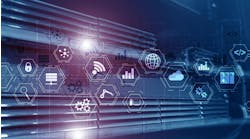Download this article in PDF format.
A virtual hotbed for robotics and automation, the warehouse has become a focal point for companies seeking high-tech ways to augment human labor, gain efficiencies, improve work throughput and adapt to workplace social distancing requirements. The latter is a particularly big driver right now as companies deal with both a constrained labor market and the ongoing need to do “more with less.”
The push to automate the modern warehouse is expected to continue for the foreseeable future. According to Gartner, demand for robotic goods-to-person (G2P) systems will quadruple by 2023, with social distancing in the warehouse as one of the key drivers. The research firm also predicts that through 2024, 50% of supply chain organizations will invest in applications that support artificial intelligence (AI) and advanced analytics (AA) capabilities.
What is Goods-to-Person?
With G2P, incoming goods are removed from pallets, either manually or automatically, in the warehouse or distribution center. The cartons and/or pieces are then placed into totes (smaller goods) or into trays (larger goods), and stored in high-density automated storage and retrieval systems (ASRS), carousels or robotic systems.
“As orders are required to be fulfilled SKUs are automatically retrieved from storage and brought to the picker, either at a pick station where the operator picks into an order container or to an ergonomic palletizing station where items are placed on a pallet,” Material Handling & Logistics explains. “Since the picker does not have to walk, the focus at the pick stations and pack stations is on ergonomics and high productivity.”
Companies have been using G2P for years, with the global pandemic accelerating their interest in putting more robots on their warehouse floors. “Fallout from the COVID-19 pandemic is increasing demand for robotics in warehouses and distribution centers,” said Dwight Klappich, VP analyst with the Gartner Supply Chain practice, in a press release. “G2P systems are an easy and economical way to not only enforce social distancing, but also improve productivity.”
Using Tech to Solve Problems
According to Gartner, companies are using different technologies to address social distancing in warehouses—including those that trace each employee’s move—but it says robotic systems are easier to implement and less invasive. “Keeping people in place and using a virus-resistant robot to move goods around respects people’s privacy and keeps them safe at the same time,” Klappich said.
The G2P systems also drive broader long-term improvements in efficiency and productivity, Gartner adds, while advanced systems also offer additional benefits such as improved storage density.
The Perfect Storm
Warehouse labor isn’t easy to find, demand for industrial real estate is strong, and the e-commerce boom is going full speed ahead. Combined, this “perfect storm” of outside factors make automation and robotics a compelling choice for product-centric companies that are looking for options.
“The COVID-19 pandemic has amplified the need for supply chain organizations to seek tools that help them make better and more informed decisions faster,” said Andrew Stevens, senior director analyst with the Gartner Supply Chain practice, in the press release.
“Leading organizations use AI and AA to dig through the vast amounts of data they generate to understand what is happening in their business now,” he continued, “and more importantly, what is likely to happen in the future.”
What’s the Outlook?
Looking ahead, Gartner expects companies to continue investing in applications that embed, augment or apply AI and AA tools. In most cases, these applications help address foundational areas such as data quality or connecting disparate silos. Others are more focused on helping companies migrate over to using more automated, resilient and smarter applications.
“Supply chain leaders should adopt a broad and holistic perspective when it comes to AI and AA,” Stevens said. “These technologies are increasingly ubiquitous, and there are many ways in which they can be applied—such as data mining for smart manufacturing, visibility tools and autonomous transportation, and to aid customer retention.”










